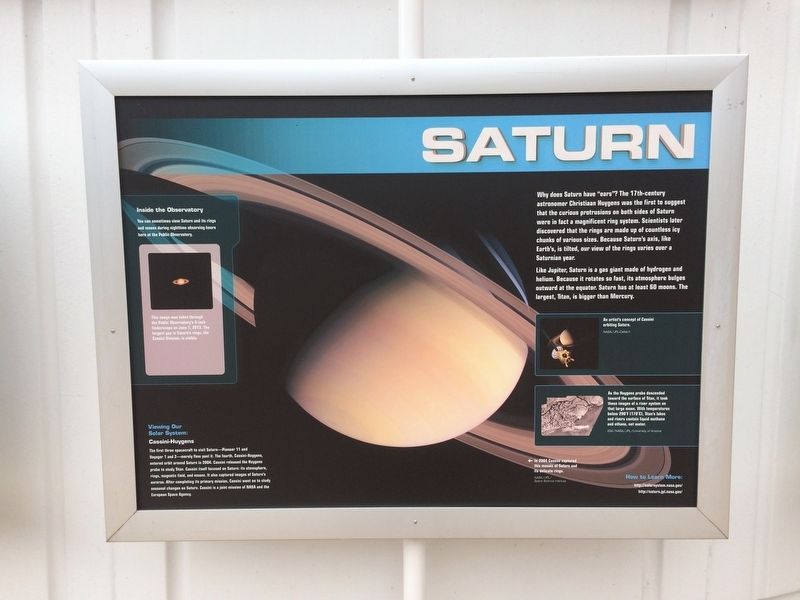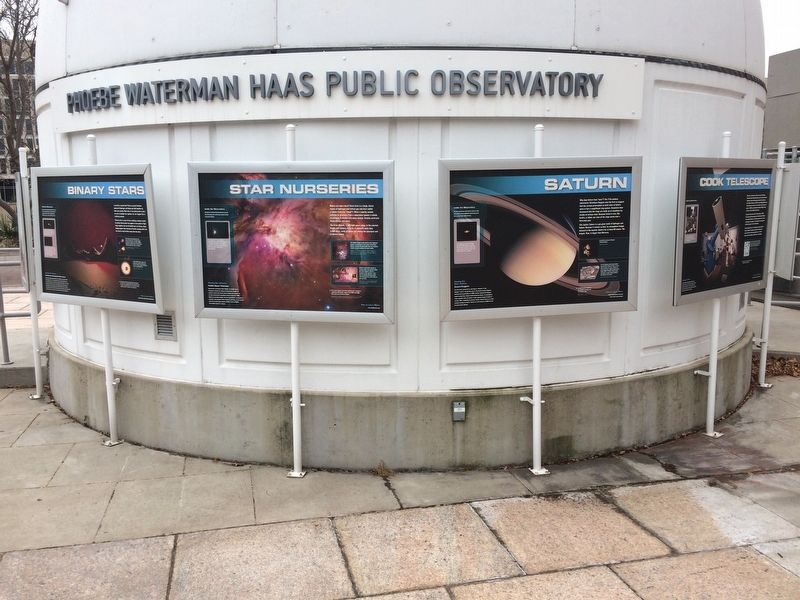The National Mall in Southwest Washington in Washington, District of Columbia — The American Northeast (Mid-Atlantic)
Saturn
Why does Saturn have "ears"? The 17th-century astronomer Christiaan Huygens was the first to suggest that the curious protrusions on both sides of Saturn were in fact a magnificent ring system. Scientists later discovered that the rings are made up of countless icy chunks of various sizes. Because Saturn's axis, like Earth's, is tilted, our view of the rings varies over a Saturnian year.
Like Jupiter, Saturn is a gas giant made of hydrogen and helium. Because it rotates so fast, its atmosphere bulges outward at the equator. Saturn has at least 60 moons. The largest, Titan, is bigger than Mercury.
Captions:
Inside the Observatory
You can sometimes view Saturn and its rings and moons during nighttime observing hours here at the Public Observatory.
The image was taken through the Public Observatory-s 4-inch finderscope on June 1, 2013. The largest gap in Saturn's rings, the Cassini Division is visible.
Viewing Our Solar System:
Cassini-Huygens
The first three spacecraft to visit Saturn—Pioneer 11 and Voyager 1 and 2—merely flew past it. The fourth, Cassini-Huygens, entered orbit around Saturn in 2004. Cassini released the Huygens probe to study Titan. Cassini itself focused on Saturn: its atmosphere, rings, magnetic field, and moons. It also captured images of Saturn's auroras. After completing its primary mission, Cassini went on to study seasonal changes on Saturn. Cassini is a joint mission of NASA and the European Space Agency.
An artist's concept of Cassini orbiting Saturn.
NASA/JPL-Caltech
As the Huygens probe descended toward the surface of Titan, it took these images of a river system on that large moon. With temperatures below 290°F (170°C), Titan's lakes and rivers contain liquid methane and ethane, not water.
ESA/NASA/JPL/University of Arizona
←In 2004 Cassini captured this mosaic of Saturn and its delicate rings.
NASA/JPL/Space Science Institute
How to Learn More:
http://solarsystem.nasa.gov
http://saturn.jpl.nasa.gov
Erected by National Air and Space Museum.
Topics. This historical marker is listed in this topic list: Air & Space. A significant historical year for this entry is 2004.
Location. 38° 53.273′ N, 77° 1.112′ W. Marker is in Southwest Washington in Washington, District of Columbia. It is in The National Mall. Marker can be reached from Independence Avenue Southwest west of 4th Street Southwest, on the right when traveling west. On the grounds of the National Air and Space Museum on the side of the Phoebe Waterman
Other nearby markers. At least 8 other markers are within walking distance of this marker. Phoebe Waterman Haas (here, next to this marker); Moon (here, next to this marker); Venus (here, next to this marker); Jupiter (here, next to this marker); Binary Stars (here, next to this marker); Sun (here, next to this marker); Cook Telescope (here, next to this marker); Star Nurseries (here, next to this marker). Touch for a list and map of all markers in Southwest Washington.
Credits. This page was last revised on January 30, 2023. It was originally submitted on December 12, 2017, by Devry Becker Jones of Washington, District of Columbia. This page has been viewed 188 times since then and 20 times this year. Photos: 1, 2. submitted on December 12, 2017, by Devry Becker Jones of Washington, District of Columbia. • Bill Pfingsten was the editor who published this page.

